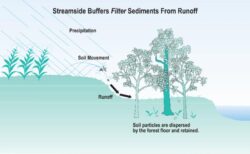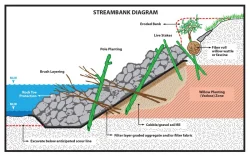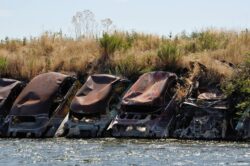Many Montana landowners are currently watching their waterfront property heading downriver. It is sad to see their dreams and memories turning into a nightmare. Sadly, this erosion and shore destruction is avoidable.
The Yellowstone River and so many waters are in charge. No matter how many gabions you create, and prayers you make, the riverbanks belong to the rivers. Each year we have an annual runoff that can devastate shorelines and create new channels. Rivers will take back what riverfront landowners took.
This recent flood season reminds me of the same breed of landowners that build shoreline homes along the oceans edge. They are surprised when a hurricane, high tide, or normal erosion happens. You would think that these folks would figure it out and consider moving their builds to a saver location. 
100 feet is a place to start. Nature can protect her own riverbanks. Trees, long roots, and natural shore contours have directed waterflows for eons. If new shoreline landowners would simply leave 100 feet of shoreline alone, they may be able to save the rest of the developed property.
The shorelines are so inviting. Landowners want to develop these fragile edges into piers, stairways, decks, mow the shorelines, and build their home close enough to be near the river. This idea is now paying the rivers toll. Floods like these years don’t happen every season. We want great runoff to prevent forest fires, nourish the land, and clean out the rivers. The rivers are living up to its part. 
The Chesapeake Bay is another good example. Everyone wants shorefront property. They build their piers, bulkheads, and verandas on the very edge. Floods and high water do its best to take it back. The attraction of shoreline development is just so strong, until it gets washed away.
The data that surprised me was that if the Chesapeake Bay, and its watershed had a 100-foot buffer along and around it, there would be limited flood damage and pollution. Planting trees and long rooted plants would absorb pollution before it gets to the water. Many responsible landowners have done this. Between these buffer folks are the scattered buffer less people mowing to the sand beach.
Landowners often respond to any ideas with, “This is my land, I can do what I want!” They are now watching their homes drift away. “That was your land…” Maybe our rivers and watersheds need some new regulations. The good of the many is important too. 100-foot/yard buffers would only increase the value of property and decrease insurance costs.
Natural development of waterfronts can be beautiful and effective. State agencies will help you plan and design an erosion solution for your waterfront. This plan will protect your property, enhance habitat for wildlife, and increase the land values. Start first by looking at a flood map. This will identify where the water may impact and flood your dreams.
This flood event was a 1,000-year event. Floodwaters can scour just about anything that humans make. When people try to rebuild, do so with a plan and educated purpose, not just a truckload of boulders or old car bodies. At least we can get it right in our lifetime. 
Your property may need some channelizing, flood ponds, revetments, or gabion reinforcement. Your land may also be in the wrong place to do anything. Look at an aerial photo of the area. Common sense will tell you places that are foolish to build. Even 100 yards may not be enough. Huge storm events do huge damage. Water hydraulics are powerful. It is also important for the entire shoreline community to get on board with protections and improvements. A simple start is to develop far back from the waters edge.
100 feet is good but maybe 100 yards is better. As shore owners try to regroup after finding the river in their living rooms, maybe plan and prepare for the next high-water event. Walking through a forest or natural field is a simple solution to create a special trail to the waters edge. Do your homework, consult stream morphology experts, invite state agencies to help you make a plan.
If you live near the waters edge, you want to be able to protect it and your property.
Montana Grant